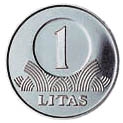 The litas has been pegged to a foreign currency for twenty years now. With the introduction of the currency board model in 1994, the litas was pegged to the U.S. dollar and in 2002 it was re-pegged to the euro. On the 1st of April, 2014 we are celebrating the 20th anniversary of the Lithuanian Currency Board. For two decades, this system has secured a strong Lithuanian litas and a more stable economy.
The litas has been pegged to a foreign currency for twenty years now. With the introduction of the currency board model in 1994, the litas was pegged to the U.S. dollar and in 2002 it was re-pegged to the euro. On the 1st of April, 2014 we are celebrating the 20th anniversary of the Lithuanian Currency Board. For two decades, this system has secured a strong Lithuanian litas and a more stable economy.
“When we talk about the litas or the euro adoption, what we have to think about in the first place is whether our currency is reliable and safeguards our economy. For the last two decades the currency board has been the guarantor of our economy and litas stability. People have trusted the litas as they have known that its value remains stable. People could plan their income and expenditure without having to worry that their savings might become worthless tomorrow,” LFMI’s senior policy analyst Vytautas Žukauskas says.
The most important feature of the currency board is one hundred percent foreign currency reserves which ensure that every litas in circulation can be covderted into the reserve currency at a fixed rate. At first Lithuania had the US dollar as the base currency at $1=LTL4, and since 2002 the litas has been pegged to the euro at €1=LTL3.4528.
Under the currency board system the Bank of Lithuania cannot print money without reserve backing. The amount of money in circulation depends not on the decisions of the central bank but on the amount of the anchor currency – the euros – exchanged to the litas. In countries which do not have a currency board, the central banks can increase the amount of money, thereby leading to price increases.
“Before adopting the euro the main question we should ask is whether the euro meets currency reliability criteria. We can have a stable currency only if we limit the central bak’s appetite to print money. We have to join the euro zone with a strong and clear position that the European Central Bank should not be allowed to manipulate the money. Multiplication of money without reserve backing causes inflation which is at the root of many economic problems,” Vytautas Žukauskas notes.
In 1993 price increase reached 189 percent in Lithuania, while in 1994, with the adoption of the currency board system, it fell to 45 percent and after another couple of years it shrank to 13 percent and never came near this level.
Estonia had used the currency board model until it adopted the euro. The currency board is still operational in Bulgaria and some other countries.
Since its establishment in 1990, LFMI has actively participated in creating banking legislation and has advocated a transparency and reliable monetary policy protected from political and private interests.
On the occasion of the 20th anniversary of the currency board we present the most important papers, articles and commentaries on the currency board (in Lithuanian): http://www.llri.lt/iniciatyvos/lietuvos-valiutu-valdybai-20-metu